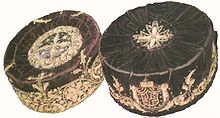- Montenegrin cap
-
The Montenegrin cap (Serbian: Црногорска капа, Crnogorska kapa or simply Kapica) is a cap traditionally worn by Montenegrins and Serbs of Montenegro. Originally worn by males, it is now not exclusively for them.
The cap is originally in the shape of a flat cylinder, having a red upper surface (called tepelak) not dissimilar to the Herzegovina and Lika caps. Prince-Bishop Petar II Petrović Njegoš wore it with a black rim (called derevija),[1] and the definition given was as a sign of grief of occupied Kosovo. The Kosovo myth was very popular in the old Montenegrin state. The enforcement of the cap upon the Montenegrin chieftains by Prince-Bishop Peter II Petrovic-Njegos was a mark of expression of then's dominating Serbian national identity.[2]
The national telling recorded the most often version of the cap as following: the black wrapper was sign of grief for their once great Empire, the red the bloody defeat at the Battle of Kosovo[3] and the five small stripes on the top represent the remaining remains of the once greater Serbian realm,[4] which became increasingly popular amongst the common folk during the reign of Prince Danilo I Petrović-Njegoš. Within the stripes is angled a six star, representing the last free part, Montenegro, shining upon the fallen and conquered.[5]
Prince Danilo in the many variations introduced his initials "ДI" (Danilo the 1st), while his successor Prince Nikola in the second half of the 19th century replaced it with "Н.I", quite often alongside the letter "Ж" signifying "Живио" (Long live!).
During the Communist era in the second half of the 20th century instead of the Serb cross the Communist Red Star was implanted between the golden stripes, although it was not spread amongst the people and never accepted. Several years ago a new version appeared with a large modern (2004) Coat of Arms of Montenegro spread across the cap's red top, that is becoming increasingly popular as a sign of the Montenegrin nation's independence and sovereignty. A female version of the cap was introduced, so far worn almost exclusively by men.
See also
References
Categories: Montenegrin clothing | Caps
Wikimedia Foundation. 2010.




